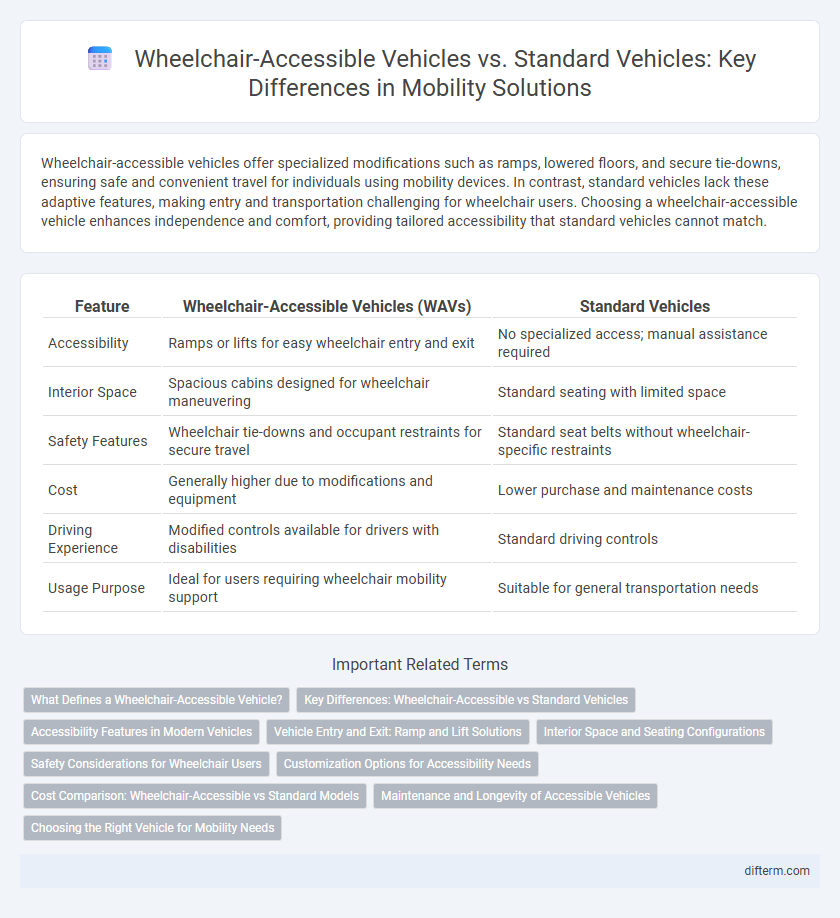Wheelchair-accessible vehicles offer specialized modifications such as ramps, lowered floors, and secure tie-downs, ensuring safe and convenient travel for individuals using mobility devices. In contrast, standard vehicles lack these adaptive features, making entry and transportation challenging for wheelchair users. Choosing a wheelchair-accessible vehicle enhances independence and comfort, providing tailored accessibility that standard vehicles cannot match.
Table of Comparison
| Feature | Wheelchair-Accessible Vehicles (WAVs) | Standard Vehicles |
|---|---|---|
| Accessibility | Ramps or lifts for easy wheelchair entry and exit | No specialized access; manual assistance required |
| Interior Space | Spacious cabins designed for wheelchair maneuvering | Standard seating with limited space |
| Safety Features | Wheelchair tie-downs and occupant restraints for secure travel | Standard seat belts without wheelchair-specific restraints |
| Cost | Generally higher due to modifications and equipment | Lower purchase and maintenance costs |
| Driving Experience | Modified controls available for drivers with disabilities | Standard driving controls |
| Usage Purpose | Ideal for users requiring wheelchair mobility support | Suitable for general transportation needs |
What Defines a Wheelchair-Accessible Vehicle?
A wheelchair-accessible vehicle (WAV) is specifically designed or modified to accommodate passengers using wheelchairs, featuring ramps or lifts, lowered floors, and extra interior space for maneuverability. These vehicles meet accessibility standards such as the Americans with Disabilities Act (ADA) guidelines or similar regulations in other countries, ensuring safe and comfortable transportation for wheelchair users. Unlike standard vehicles, WAVs provide enhanced ease of entry and securement systems that allow independent or assisted travel for people with mobility impairments.
Key Differences: Wheelchair-Accessible vs Standard Vehicles
Wheelchair-accessible vehicles feature specialized modifications such as ramps, lifts, and spacious interiors to accommodate mobility devices, unlike standard vehicles that lack these adaptations. These vehicles prioritize ease of entry and exit, safety, and comfort for individuals using wheelchairs, ensuring compliance with accessibility standards. Standard vehicles typically offer limited space and do not provide tailored accessibility solutions, making them less suitable for passengers with mobility impairments.
Accessibility Features in Modern Vehicles
Wheelchair-accessible vehicles incorporate specialized features such as ramp or lift systems, widened doorways, and lowered floors to facilitate easy entry and securement for mobility devices, ensuring independent travel for users with disabilities. In contrast, standard vehicles lack these modifications, often requiring additional assistance or costly adaptations for wheelchair users. Modern accessibility technologies also include hand controls, swivel seats, and voice-activated systems designed to enhance comfort and usability for individuals with limited mobility.
Vehicle Entry and Exit: Ramp and Lift Solutions
Wheelchair-accessible vehicles feature specialized ramp and lift systems designed for smooth vehicle entry and exit, ensuring safety and convenience for users with mobility challenges. These adaptive solutions often include fold-out ramps or hydraulic lifts, which accommodate various wheelchair types and sizes, unlike standard vehicles that lack such modifications. Enhanced entry mechanisms in accessible vehicles significantly reduce physical strain and increase independence for passengers using wheelchairs.
Interior Space and Seating Configurations
Wheelchair-accessible vehicles feature spacious interiors with adaptable seating configurations that prioritize ease of movement and secure wheelchair placement, offering greater flexibility compared to standard vehicles. These specialized layouts often include removable or foldable seats to maximize floor space and provide comfortable, safe accommodations for passengers with mobility needs. Standard vehicles typically lack such tailored design elements, resulting in limited accessibility and fewer seating arrangement options.
Safety Considerations for Wheelchair Users
Wheelchair-accessible vehicles feature specialized safety systems such as securement tie-downs and integrated restraint harnesses that exceed the protection offered by standard vehicles, reducing the risk of injury during transit. These vehicles also incorporate reinforced flooring and customized seating to enhance stability and minimize movement for wheelchair users. In contrast, standard vehicles often lack these tailored safety adaptations, making them less suitable for the secure transportation of individuals using wheelchairs.
Customization Options for Accessibility Needs
Wheelchair-accessible vehicles offer a range of customization options not typically available in standard vehicles, including lowered floors, ramp or lift installations, and adaptive seating configurations to accommodate various mobility aids. These modifications enhance ease of entry and exit, provide secure wheelchair tie-down systems, and ensure driver and passenger comfort tailored to individual accessibility requirements. Customizable features such as hand controls, swivel seats, and increased interior space promote independence and safety for users with diverse mobility challenges.
Cost Comparison: Wheelchair-Accessible vs Standard Models
Wheelchair-accessible vehicles typically cost between $30,000 and $60,000 more than standard models due to specialized modifications like ramps, lowered floors, and securement systems. While the upfront investment is higher, these vehicles often reduce the need for additional mobility aids or transportation services, potentially lowering long-term expenses. Insurance coverage and grants can help offset the price difference, making accessibility-focused vehicles a valuable investment for many mobility-impaired individuals.
Maintenance and Longevity of Accessible Vehicles
Wheelchair-accessible vehicles often feature reinforced suspension systems and specialized drivetrains designed to support additional weight and modifications, which can increase maintenance complexity compared to standard vehicles. Routine inspections of ramps, lifts, and wheelchair securing mechanisms are crucial to ensure safety and prolong the functional lifespan of accessible vehicles. High-quality components and regular professional servicing contribute to enhanced durability and reduce long-term repair costs for wheelchair-accessible transportation.
Choosing the Right Vehicle for Mobility Needs
Wheelchair-accessible vehicles (WAVs) offer specialized modifications such as ramps, lowered floors, and securement systems that ensure safe and comfortable transportation for individuals with mobility challenges. Standard vehicles lack these adaptations, often requiring additional equipment or assistance, which can limit independence and accessibility. Selecting the right vehicle involves assessing specific mobility requirements, ease of entry and exit, space for wheelchair storage, and overall usability to enhance daily mobility and quality of life.
wheelchair-accessible vehicles vs standard vehicles Infographic

 difterm.com
difterm.com